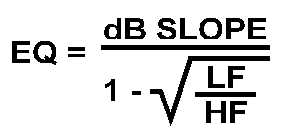| Fixed Value
Equalizer Selection |
| |
| Quality RF Services now offers QLX fixed
equalizers to replace the Jerrold JLX (EQ-*) equalizer. The QEP-ADP adapter lets
these low-cost equalizers replace the SEP and QEP family of variable equalizers. The
advantages are better system noise figure due to lower insertion loss and NO adjustments
to cause system response errors. |
| The QLX equalizers are offered in 2 dB incremental
values from 2 to 30 dB in 330, 350, 400 and 450 MHz series. The 550 MHz series for
line extenders range from 2 to 28 dB. Equalizer values are selected to provide a flat
input to the trunk module. Use the following formula to select the values after
measuring the levels of the highest and lowest frequency video carriers. The
difference in the carrier levels is dB SLOPE. LF is the frequency of the low-end carrier
and HF is the frequency of the high-end channel. |

|
Since the bottom of the fraction is always constant
for a given cable system, a constant (K) factor may be computed for later division into
tilt values measured in the field. For a 450 MHz system the value is: System (K) = 1 - {SQRT (55.25/445.25) = 0.6477 |
|
